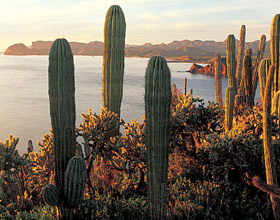 |
 |
 |
 Editorials | Environmental | July 2005 Editorials | Environmental | July 2005  
Gulf of California Given Spotlight as U.N. World Heritage Site
 Sandra Dibble - Union-Tribune Sandra Dibble - Union-Tribune


| | Millions of years ago, the Baja California peninsula broke off from the mainland of present- day Mexico. The Pacific Ocean rushed in, creating the Gulf of California, or as it is known in the United States, the Sea of Cortez. Today, rugged coastlines, lagoons, coral reefs and palm oases mark the region where the Baja desert meets the sea. (Photo: George H. Huey) |
With its rich marine life and numerous endemic species, the Gulf of California has been called "the world's aquarium." Last week, the region joined an exclusive club that of U.N. World Heritage sites.

As development pressures increase along the gulf's shores, conservation groups in the United States and Mexico are celebrating their role in bringing about the distinction to 244 uninhabited islands, islets and their surrounding waters.

"It should have been there from the start," said Ernesto Enkerlin, head of Mexico's National Commission for Protected Areas. "If there's some kind of aggressive development, we would hope that this will help us curtail or prevent it."

The Mexican government in 1978 conferred protected status on the archipelago of more than 900 islands in the Gulf of California, also known as the Sea of Cortez. The World Heritage Committee's designation, limited to the most closely studied islands, does not create additional safeguards, but proponents say it puts an important spotlight on the region.

"It's creating responsibility. It's creating visibility. It's creating international attention," said Enkerlin. "In the future, we need to do at least as well as now or better."

The designation can be a powerful tool. Environmentalists used the 1993 World Heritage designation of Baja California's coastal lagoon of San Ignacio to help defeat a proposed salt plant in 2000.

"This will make it much easier for government officials as well as others to help keep it as pristine as it is," said Michael Hager, executive director of the San Diego Natural History Museum.

The designation was made last week in Durban, South Africa, by the World Heritage Committee of the U.N. Educational, Scientific and Cultural Organization, known as UNESCO. It is the third natural area in Mexico with the status: the other two are Sian Ka'an, a biosphere reserve on the Yucatan peninsula that includes tropical forests, mangroves and marshes; and the lagoons off the Baja California peninsula frequented by migrating whales.

Turquoise waters, brilliant desert reflection and the "striking natural beauty in a dramatic setting formed by rugged islands with high cliffs and sandy beaches" are described in the islands' designation.

The site is home to 695 plant species, more than any other on the World Heritage list. It contains 891 fish species, 90 of them endemic or native, according to the designation; it includes 39 percent of the world's species of marine mammals and a third of the world's marine cetacean species.

"Almost all major oceanographic processes occurring in the planet's oceans are present in the property, giving an extraordinary importance for study," a UNESCO statement says.

The effort to include the region in the World Heritage list was suggested by a Mexican nongovernmental organization, the Mexican Foundation for Environmental Education, or FUNDEA.

But crucial support also came from north of the border. An important player was the San Diego Museum of Natural History, through its scientific studies, educational programs and the acclaimed IMAX film "Ocean Oasis" funded by the museum and the Mexican conservation group Pronatura.

In Mexico, the recognition "sends a very strong message," said Exequiel Ezcurra, the museum's director of scientific research and former director of Mexico's National Institute of Ecology. "It tells the nation that their government and committed NGOs (nongovernmental organizations) want to protect this site."

Ezcurra said much of the scientific information presented for the designation came from research at the museum. A crucial document was the book "A New Island Biogeography of the Sea of Cortιs," produced by the museum, the University of California Los Angeles and the University of California San Diego.

Another San Diego-based supporter of the designation has been the International Community Foundation, which worked with other conservation groups to purchase a Gulf of California island, Isla Espiritu Santo, in 2003 from a land cooperative to protect it from development.

The World Heritage site designation can bring more funds to the area and more tourists, both of which can present benefits and challenges, said foundation President Richard Kiy. "It will bring new opportunities for the whole region, but communities will have to be good stewards," Kiy said. | 
 | |
 |



